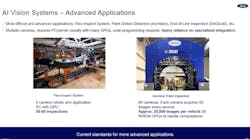Honeywell International Inc. (IW500/29)’s aerospace halo is worth its weight in jet fuel.
The $120 billion conglomerate reported its third-quarter results on Thursday, and while there was evidence of the slowdown gripping the rest of the manufacturing industry, there was also proof that everything that’s made Honeywell an industrial darling of Wall Street this past year still holds true. On the one hand, Honeywell cut its 2019 sales outlook. Revenue at its safety and productivity unit slumped 8% in the third quarter, excluding the impact of currency swings and M&A, as inventory piled up and projects got pushed out. Offsetting that bleak result was Honeywell’s aerospace division, which delivered robust 10% organic revenue growth. And Honeywell raised its 2019 earnings forecast.
So in the end, what could have been an ugly earnings day for Honeywell ended up eliciting a polite clap. As trading began in New York, the stock was up about 1%.
For Honeywell and other industrial companies, aerospace has been a rare bright spot at a time when many other sectors, particularly automotive, electronics and increasingly construction-related businesses, are slowing down. The decline appears to be accelerating: railroad Union Pacific Corp. on Thursday reported an 8% slump in carload volumes in the third quarter while construction-rental equipment company United Rentals Inc. trimmed its revenue guidance late Wednesday. Meanwhile, a report from the Federal Reserve on Thursday showed that U.S. factory output declined in September by the most in five months as a strike at General Motors Co., the trade war and generally sluggish demand weighed on production.
The sustainability of the years-long aerospace boom has come into question as a wobbling Chinese economy and the prolonged trade war risk damping demand for travel. Global passenger traffic grew 3.8% in August, well off the pace of the past few years, according to the International Air Transport Association. But that’s still growth, at least for now. Parts makers like Honeywell are also seeing more demand for services on older aircraft while the Boeing Co. 737 Max remains grounded.
In its earnings presentation, Honeywell said it expects further growth in commercial flight hours and the rollout of new jet programs to continue to boost sales at the aerospace division in 2020. Margins may get squeezed, because the business will tilt more heavily toward the less profitable work of installing new equipment versus maintaining older versions.
The generally upbeat aerospace narrative contrasts with downbeat performances elsewhere at the company. The sales decline at the safety and productivity unit was the worst for the business since 2016, when the manufacturing sector was emerging from a mini-recession sparked by the plunge in oil prices. Margins in the safety and productivity business fell 320 basis points to 13.4%. Honeywell still recorded healthy growth in its chemicals and materials unit and building-technologies division, but the pace slackened from the second quarter. Honeywell now expects total company organic sales to grow at best 5% this year, down from an earlier projection of as much as 6%.
Amid what it deemed an “uncertain macro environment,” Honeywell reiterated its ability to protect its earnings through a downturn by continuing to cut costs and using its ample balance sheet for M&A and share buybacks. CEO Darius Adamczyk has largely sat comfortably on the M&A sidelines the past few years, holding out for lower valuations that may now be coming. There had been some concern when he took over from former leader Dave Cote and talked passionately about accelerating Honeywell’s revenue growth that such an effort would come at the expense of the company’s almost religious commitment to margin improvements. That concern was ill-founded. Honeywell boosted its margin guidance for the full year in part because of the benefits of previously funded restructuring, operating improvements and the spinoffs of the less profitable Garrett Motion Inc. turbocharger and Resideo Technologies Inc. consumer-facing home products businesses last year.
Honeywell is making a good case for why it’s a decent place to hide in the event of a manufacturing slowdown, or perhaps broader recession. But the fact that it’s making this argument increasingly loudly should be a warning for the rest of the industrial sector.
by Brooke Sutherland




